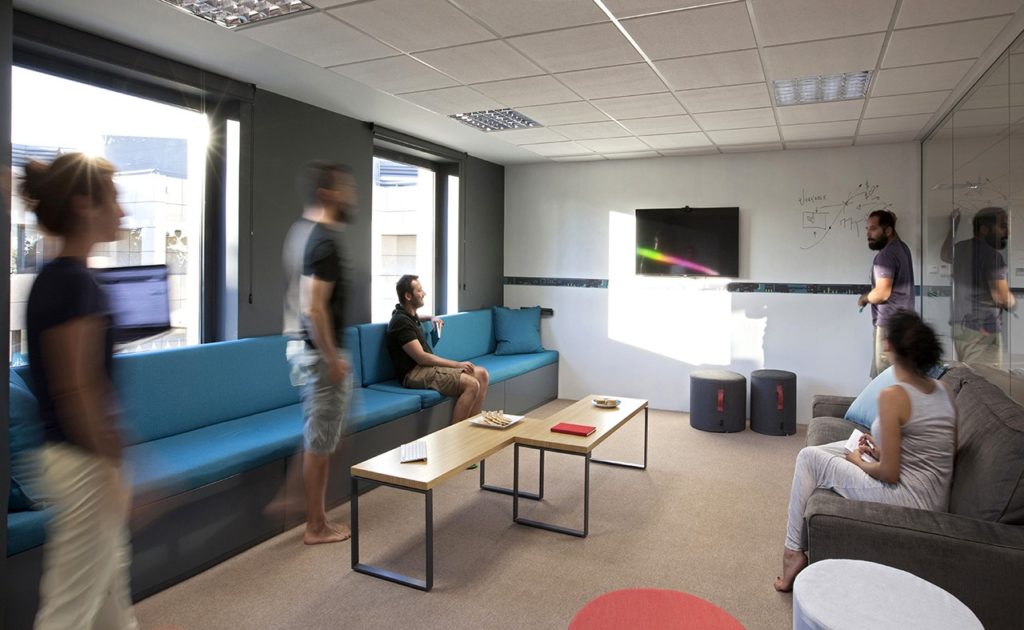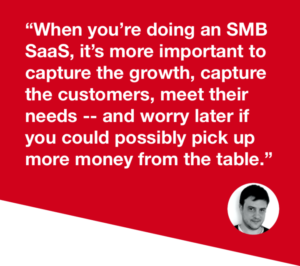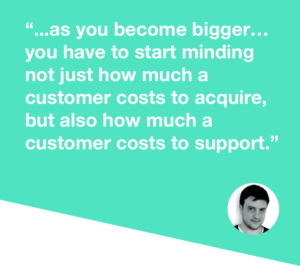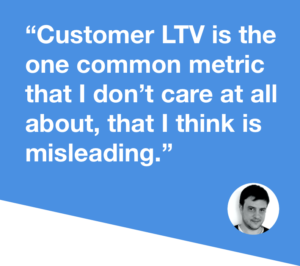You can also check out this interview on the SaaS Open Mic Podcast, or subscribe on iTunes:
https://soundcloud.com/chartmogul/episode-01
Ed: First tell us about Workable.
Nikos: Workable is a SaaS software aimed at SMB. What we do is everything around the hiring process. From the moment you make a job description to the moment you put an offer letter to someone. We manage everything — from careers pages, collecting applicants, syndicating your jobs and advertising them, getting your talent pool, helping you collaborate with your colleagues to discuss candidates and manage interviews. The field is typically called “applicant tracking system,” which I really don’t like at all because it’s really old fashioned.
Ed: Okay, so it’s managing that whole process end-to-end and giving it a complete solution. How did you guys start? What’s the founding story?
Nikos: The company started three years ago, but the product has been on the market for about two. We started in Greece, not a very likely place to start that kind of thing! But by now it’s grown to be a very international company. Our base is in the United States in Boston — I moved here recently and a lot of our people are here.
Right now we have 3,300 business customers all over the world; 60% of them are in the US. We are over $5 million ARR and growing at 15% month-over-month. So it’s been doing reasonably well recently. We raised a round of $27 million led by Balderton and Notion. Basically, we’re in that phase where we want to scale the business.

SaaS business model and pricing
Ed: There are a lot of good sounding numbers in there so it sounds like things are going pretty well for you guys! If you look back to when you were building the product, was it clear to you from the beginning that the SaaS business model made sense for this product — or did you know from the beginning how you would map that out and how you would price it?
Nikos: To be honest with you… No, we didn’t have a very clear idea of everything when we started. We were total noobs back then. But I guess if you start a software company today, it’s likely going to be a cloud software company. It’s likely going to be delivered with a SaaS business model. So, at the time, I don’t think we considered an alternative.
What is special about Workable is the targets; it fits SMB very squarely. We are not starting with the small companies with clear intention to go massively upmarket, which is most common. We are actually doing an SMB play. And in terms of pricing, exactly how models and metrics work, things are a little bit distorted on our end because you touch the consumer side of metrics and marketing.
Ed: I noticed you guys have five different pricing tiers on your site. Is that to capture the spread of the market that you’re addressing? Was it always that way?
Nikos: Actually yes, we haven’t changed pricing all that much. There’s two ways to see that: either we were right all along …or we’re too late to change our pricing. I think for most companies at our stage, it’s probably the second. And it’s one thing that I think about a lot. But to be honest with you, we don’t focus too much on that aspect. When you’re doing an SMB SaaS, it’s more important to capture the growth, capture the customers, meet their needs — and worry later if you could possibly pick up more money from the table.
SaaS Growth metrics
Ed: In terms of capturing and measuring SaaS growth, how do you measure yourselves and what metrics are really important to you? I guess there are some metrics that you look at everyday and use as an indicator for growth of the product.
Nikos: Well, all the obvious SaaS metrics that most people are looking at. MRR, the movements of MRR. We’re looking at churn a lot. I think what’s also not so common but common in our case: we have a lot of small customers that come and go. The interpretation of churn is harder, because a lot of our smaller customers are just using it for four months, and then four months later on. We have a strong reactivation component. So, there are some interesting metrics like the percentage of revenue coming from reactivation, which you can only judge on the basis of the customers that have already been lost, not the customers you have. On the low end of the market, in some of those metrics you might see slight differences in interpretation.
But in general, yes we follow the metrics that I see everyone else track. I think that’s a very well-documented part of the business, as well. The business model has matured. If I were starting today, I think in two weeks I could figure out exactly how to monitor and run the business. Of course with a tool like yours, I could even implement it in a day.

SMB churn / Seasonality / Reactivation
Ed: It’s interesting you mentioned your level of reactivation MRR. I’ve seen a lot of small businesses talk about the problem of customers coming on board for a couple of months, getting the value out of the product, and then leaving again. Is that something you would try to fix in the product, or is that not a problem for you guys because you’re able to measure it — and you know they’ll come back when they need your service again?
Nikos: That’s the thing. If you apply traditional enterprise SaaS thinking on a situation like that, you see a problem where there isn’t one. And you’re trying to fix it by actually forcing behaviors that don’t fit the customers. That’s the conclusion that I’ve arrived at.
In our case, really small businesses may not be hiring all the time. They may only be hiring once or twice a year. So for them to pay subscription prices all year long doesn’t make sense. To lose their data and start again doesn’t make sense. So one thing that they appreciate about Workable is they can use it for three months, pause it, and come back find all of their data and restart the subscription. And when you look at these customers saying, “I’m canceling my subscription, but I’m really happy and I’ll use it again!” Then you shouldn’t think, “Oh, how do I make these people stay longer?” The thing you have to think about is: How do I make sure the next time they need this, they remember who I am and they come back to me?
 So, let’s say you have a second order marketing machine. Some people who are in your database: They are customers, they’ve been customers in the past, they know who you are, they know how to use the product. You don’t want to be spamming them with emails every month because that would be very annoying, but you somehow need to stay top-of-mind for them. And how do you track that? You track the activation as a percentage of the sleeping database that you have.
So, let’s say you have a second order marketing machine. Some people who are in your database: They are customers, they’ve been customers in the past, they know who you are, they know how to use the product. You don’t want to be spamming them with emails every month because that would be very annoying, but you somehow need to stay top-of-mind for them. And how do you track that? You track the activation as a percentage of the sleeping database that you have.
That’s an interesting discussion about metrics, by the way. In the beginning, we’re seeing reactivation as a percentage of the MRR that we currently have. But for [this situation], it’s how many sleepers do you have in there, and how do you improve [their reactivation rate].
Ed: I’m assuming that you capture that at the point of cancellation. You must be able to categorize the sleepers from the actual churn.
Nikos: To be honest with you, we don’t. I guess we could have easily put a little thing there asking them why they left, but it’s one of those things that we haven’t done. You know, when you grow really fast, a lot of the things you should have done, you just don’t do them because you’re doing the features. But in reality what you would like to do is to capture that, to understand who are the people in that category, and market to them specifically in different ways.
Relative to the discussion of metrics, none of these things can be done if you don’t appreciate how big it is for you, how important it is for you. For us for example, it’s really important. For others, it’s not.
Ed: Maybe there’s something around the notion of canceling versus pausing. It’s a semantic difference between the two.
Nikos: We used to just have “Cancel”. And the customers would say, “No I don’t want to cancel. I just want to stop for a while.” And we said, “Yes you stop, then you resubscribe.” But this wasn’t obvious. So then we made a button that said “Pause” and a separate one that says “Cancel”.
SaaS growth and cost at scale
Ed: What would you say are the main challenges for you guys growing? Based on what you’ve said, I guess you have a slightly higher churn rate than some other SaaS businesses may have. But what are the main barriers to growth for you?
Nikos: It’s not so much the churn because in SMB you have very high customer count churn. But the MRR churn is not big. In fact we have negative net churn. Because the bigger accounts plus some of the upgrades carry it, and the people who left are on the smaller plans.
I guess the challenge that I believe we will face, and I think this will be the challenge for a lot of SaaS companies as the industry matures, is that in the beginning you figure out your acquisition economics. And then you can use your channels and your acquisition economics to grow really fast. But as you become bigger, other things enter the financial equation. It’s mostly the question of margins. At a bigger scale, the acquisition economics change. The support and maintenance economics change. You need a bigger organization so then you have to start minding not just how much a customer costs to acquire, but also how much a customer costs to support.
The older generation of startup businesses, the ones who have had IPOs in the past couple of years, the playbook was that you eventually go directly up market, and you go to the customers that will pay so much that they will eventually cover all of those costs. So it’s only a challenge to grow. That’s why the focus on VCs, metrics, everybody in the industry is: “Just get the acquisition economics to grow, and then you’re not going to have to worry about it later.”
 But I think with this second wave of successful SaaS companies, we’re also looking at mid-market and smaller companies. And there the margins are not going to be solved dramatically by going upmarket. So you really need to build a streamlined, highly self-service business and to be mindful of those metrics.
But I think with this second wave of successful SaaS companies, we’re also looking at mid-market and smaller companies. And there the margins are not going to be solved dramatically by going upmarket. So you really need to build a streamlined, highly self-service business and to be mindful of those metrics.
Talking about metrics, the SaaS metrics we have are a lot about the usage and the revenue, etc. A lot of companies I see do not have very sophisticated cost-allocation mechanisms inside the company to be able to attribute from salaries, or fully-loaded costs of customer support integrated into the rest of the metrics. And that’s something we’re working on right now.
Ed: It’s definitely a challenge to capture all of those costs, everything around the core MRR/acquisition costs. That’s something I’m not sure anybody has solved yet. Would you say there’s a certain tipping point where that suddenly becomes a problem for you — or is it something that you should be thinking about that from the early stage?
Nikos: Look, I think what happens is that up until $5–10mil ARR, your main focus is: Can I have scalable sums that can help me grow really fast? But when you get in that area between 5 and 10, then even if you don’t have it yet, you can clearly see the path to 20. Maybe it’ll be a few months earlier or a few months later, but you know you’re going to get to $20mil ARR. And then you start thinking that once I get to 20, I need to build a business that can credibly claim it will have margins at scale. A business that has economics, that can use capital efficiently, that can get from 20 to 100. You can’t start thinking about that once you’re at 20, because then it would be too late.
So I think your mindset starts to shift a little bit. As you approach 10, you start thinking that the next big challenge will be [scaling to $100million ARR]. We’re at that stage. Maybe also because we’re at the low-end of the market. So if you have low price point, if your average revenue is $100–200, then it’s much more important.
Customer LTV — is it all it’s cracked up to be?
Ed: In terms of Customer Lifetime Value… is that something you care about or monitor? There’s a lot of discussion on this out there, but I’m curious to know who is actually able to estimate that and to use it.
Nikos: Customer LTV is the one common metric that I don’t care at all about, that I think is misleading. I think it’s misleading in very many ways. The most obvious one is that it’s wrong. It’s really difficult to capture the dynamics of upgrades and changes in the product, etc. I have done calculations with five different methods, including your tool, none of them reflect the minimum [value], much less the reality. When I look back on two years of data, it’s not what I see. So having someone produce a formula that makes sense.
Here’s another issue I see with customer LTV — it’s what I like to call the “Company Lifetime Value.” What I mean is that when you are VC-funded company, and you operate on 18 months of runway, and your LTV is really good — four years later, you’re not going to be there to see it. You have to be there to collect that money. I like to look at revenue per year and tune the acquisition and economics to that.

Ed: Okay so you take a fixed, yearly time range for the value, over one year.
Nikos: Yes that’s what I do. And I know in the end [the customer’s overall value] is going to be higher, but if you cannot, at the early stage, have a payback of a year or maybe a little extra (ideally less than a year), then you are just not capital-efficient enough to grow really fast. You need the money back. And I don’t care if I don’t get that money back in five years, because in a venture-funded world… if you’re not doing well in five years, then you’re not going to be there. There’s going to be competitors in five years. So I think it’s silly to discuss the revenue we’re going to be getting from today’s customers then. And to claim that this is somehow contributing to our economics.
If you’d like to learn more about Customer LTV as a metric, check out the Ultimate LTV Cheat Sheet. And if you’re curious about your own company’s LTV, get an accurate estimate with our LTV calculator.
